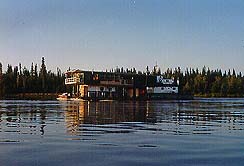|
This 1990 BLM survey project consisted of U.S. Surveys
scattered along 50 miles of the Tanana River, in central Alaska. Ms. Hartel was
assigned Chief of Parties for this project, which included seven survey crews
and all remote survey camp logistics.
No towns or native villages were close enough to the project
site to be used as an efficient base of operations. Therefore, two barges were
leased in Nenana from the Yutana Barge Lines. One barge was outfitted as living
quarters with sleeping cabins, a galley, an office area, a tool room and
maintenance area. The second barge was used to transport and store fuel and
generators and to serve as a staging area for boat operations. These two barges
were pushed by a Yutana Barge Linestugboat from Nenana to a safe mooring on the
riverAn electrical generator was set up on shore to provide power
to the barge and a landing zone was cut out of the alders to allow for a safe
approach, landing, and take-off for the helicopter. A bladder of potable water
was set up on the barge and plumbed directly to the galley on a demand system.
In addition a rain gutter system was set up, to collect rain water from the roof
and fill two designated holds on the barge with fresh drinking water. (This
became the primary supply after beavers had chewed
through the PVC plumbing of
the water bladder.) Subsistence supplies and mail was brought in by float plane
every two
weeks. Survey crews, conducting the work from both helicopter and
small boats, began their surveys downriver and worked their way easterly past
the barge until travel distance to the survey sites became to long to be safe or
efficient. At that time, a Yutana Barge Lines tugboat was called in to push the
two barges up river to another convenient mooring. The survey crews then
continued until another move was necessary. With winter closing in and the
Tanana River showing signs of freezing, it was decided to have the barges pushed
into Nenana and pulled out of the water. Dry docking the barges had no effect on
surveying production or camp operations. This project was successfully completed
and the camp demobilized on the first snow fall of the season.
|
click on image for larger view

|

